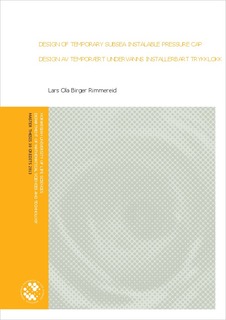| dc.contributor.author | Rimmereid, Lars Ola Birger | |
| dc.date.accessioned | 2013-08-27T11:07:53Z | |
| dc.date.copyright | 2013 | |
| dc.date.issued | 2013-08-27 | |
| dc.identifier.uri | http://hdl.handle.net/11250/189198 | |
| dc.description.abstract | The development of subsea equipment is important in the oil and gas industry because it would be beneficial if the subsea operations could be even more efficient and cost effective. Aker Solutions is one of the leading companies in this industry and they have recently launched a new horizontal connection system. Equipment to this system is under a constant development and one of the products that are not even introduced yet is the twelve inch temporary subsea installable pressure cap. In the preliminary study performed in the autumn semester of 2012, a concept proposal for this type of cap was generated. The main purpose of this master thesis was to investigate the preliminary concept and generate a new design proposal if needed. The assessment of the designs was performed with the aid of hand calculations and finite element analysis.
The project was initiated with a literature study in order to find suitable formulas and methods that were needed when dimensioning the design. Useful books were “Design of machine elements” by Bhandari V.B and “Theory of machines and mechanisms lll” by Phakatkar H.G. The former provided a practical approach on how to assess the frictional loss in linkages with pin joints, while the second one provided methods for dimensioning pin bolts and power screws. The standard “ASME 8 div. 2, rules for construction of pressure vessel (section about: design rules for clamped connections)” provided useful data when investigating what kind of clamp force that was needed.
The computer aided design software SolidWorks was used for making a three dimensional model of the design. SolidWorks Simulation was used to perform a simple simulation and it can acquire relatively quick indication of the stress behavior of a design with simple geometry. Ansys Classic also provides a quick method to make a simple model with a fast computation time. The Ansys Classic software has the advantages of changing input variables and parameters quickly. This was performed by changing the source code of the input file when the geometry, loading and boundary conditions were altered. Abaqus software was used to achieve data for the more advanced geometries and loading scenarios and was an important tool to use when conducting results regarding the separation that occurs between the connected components. It was advantageous to use Abaqus because of the possibility of getting assistance from competent personnel within the Aker Solutions organization.
The preliminary design was rejected because it did not withstand the applied load and a new design proposal was therefore generated. Several components were assessed and modified so that the design could be more robust. The calculations and analysis carried out in this project indicates that the design can tolerate the internal pressure it is exposed for. The peak separation obtained from the simulations resulted in a separation at the sealing area of 0.31mm. It was also found that most of the effective contact area of the cap is located at the top and bottom of the connection. Several components of the locking mechanism were designed against static loads, which resulted in positive values. The total force required to be applied by the power screw was reduced from 1643kN in the preliminary design to only 286kN in the final design. The linkages have been controlled against crushing and buckling failure, which gave a safety factor of 2.6 and 6.4. The pin has been controlled for bending moment and shearing failure, which satisfy the Eurocode 3 requirement. The power screw has been controlled against shearing, buckling and crushing failure and resulted in a safety factor of 2.5, 7.9 and 5.3.
Some components need more investigation before it is a fully finished design. Also, more time is needed on the analysis to perform a convergence study and optimize the design in order to lower the stress concentrations. This is considered to be a manageable task to perform at a later stage. Another aspect that needs to be solved is the necessity of a developed guiding and alignment solution for the cap. This task has a higher degree of uncertainties, because a promising solution does not exist at the moment. | no_NO |
| dc.language.iso | eng | no_NO |
| dc.publisher | Norwegian University of Life Sciences, Ås | |
| dc.subject | PRESSURE CAP | no_NO |
| dc.subject | SUBSEA TECHNOLOGY | no_NO |
| dc.subject | TIE-IN | no_NO |
| dc.subject | HORIZONTAL CONNECTION SYSTEM | no_NO |
| dc.subject | HCS | no_NO |
| dc.title | Design of temporary subsea instalable pressure cap | no_NO |
| dc.title.alternative | Design av temporært undervanns installerbart trykklokk | no_NO |
| dc.type | Master thesis | no_NO |
| dc.subject.nsi | VDP::Technology: 500::Mechanical engineering: 570::Machine construction and engineering technology: 571 | no_NO |
| dc.description.embargo | 2018-05-31 | |
| dc.source.pagenumber | 142 | no_NO |
